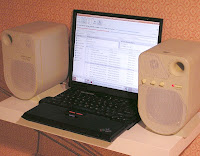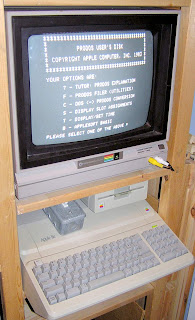 Model
Model
Introduced
CPU- Intel Mobile Pentium MMX, 200MHz (overclocked from 166MHz)
RAMVideo- NeoMagic MagicGraph 128XD (NM2160)
- 800x480 , 7.2" TFT LCD display
DiskNetworkOperating Systems- Xubuntu Linux 6.06 LTS (Dapper Drake)
Features- FIR infrared communication port
I've owned a couple of Palm compatibles and have used Blackberries for awhile; they're great but not terribly flexible. I remembered seeing a Toshiba Libretto about a decade ago and — thinking this might work better for me — I bought one from eBay. It came with a docking station but no CD-ROM drive. It didn't even have a floppy drive.
Installing Linux on it was no fun: I wanted to be able to hibernate the Libretto (have it go to sleep and wake up without having to go through the boot process) so I moved the harddrive to another PC, installed DOS on a small partition, booted it on the Libretto, and repartitioned the entire disk as a single partition. The Libretto lied to DOS about the size of the disk, leaving space on it for the hibernation partition.
Moving the harddrive back to the other PC, I used Linux to create a special partition to mark the hibernation space, deleted the DOS partition, and added a minimal partition to hold the contents of the Xubuntu install CD. After chanting and sacrificing a small goat, I got the harddrive to boot in the Libretto and run the Xubuntu install.
After the install, I moved the harddrive back into the other PC one last time, deleted the Linux install partition, and increased the size of the Xubuntu partition into the newly empty space (using the Linux
fdisk command and the reiserfs tools).
And it worked. Xubuntu Linux is the same as Ubuntu but tweaked for low power systems. The main difference is the XFCE GUI it runs, which I find really suits the small Libretto screen. OpenOffice would be too much of a pig on this device, so instead I run AbiWord for a word processor, Gnumeric for a spreadsheet, and Glom for a database. The Gimp works fine, but I've substituted Opera for Firefox (and I am quite impressed with how nicely web pages render in Opera).
The mouse on
libretto is like a TrackPoint except it's mounted to the right of the screen and you control it with your thumb. The buttons are on the opposite side of the lid from the TrackPoint (the top or outside of the lid) so when you click you essentially squeeze the lid. The TrackPoint isn't that sensitive, though, so I find I have to use a third finger to grip the case when I'm dragging things around. It took a little getting used to but works quite well.
The coolest thing is the hibernation function. When I close the lid
libretto goes into hibernation mode, saving everything in memory to the hibernation partition on the harddrive. When I open the lid, it automatically turns on and loads the hibernation partition back into memory. In a few seconds the apps and docs I had open before are back and I'm ready to continue where I left off. Very convenient.

































